Lizard
| Lizards | |
|---|---|
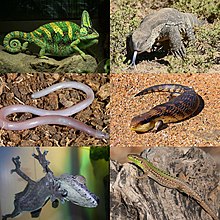
| |
| Clockwise from top left: Anelytropsis papillosus )
| |
| Scientific classification | |
| Domain: | Eukaryota |
| Kingdom: | Animalia |
| Phylum: | Chordata |
| Class: | Reptilia |
| Superorder: | Lepidosauria |
| Order: | Squamata |
| Groups included | |

| |
| Range of the lizards, all species. | |
| Cladistically included but traditionally excluded taxa | |
| |
| Synonyms | |
|
Sauria Macartney, 1802 | |
Lizard is the common name used for all squamate reptiles other than snakes (and to a lesser extent amphisbaenians), encompassing over 7,000 species,[1] ranging across all continents except Antarctica, as well as most oceanic island chains. The grouping is paraphyletic as some lizards are more closely related to snakes than they are to other lizards. Lizards range in size from chameleons and geckos a few centimeters long to the 3-meter-long Komodo dragon.
Most lizards are quadrupedal, running with a strong side-to-side motion. Some lineages (known as "
Lizards make use of a variety of
Anatomy
Largest and smallest
The adult length of species within the
Distinguishing features

Lizards typically have rounded torsos, elevated heads on short necks, four limbs and long tails, although some are legless.
As in other reptiles, the skin of lizards is covered in overlapping
The dentitions of lizards reflect their wide range of diets, including carnivorous, insectivorous, omnivorous, herbivorous, nectivorous, and molluscivorous. Species typically have uniform teeth suited to their diet, but several species have variable teeth, such as cutting teeth in the front of the jaws and crushing teeth in the rear. Most species are pleurodont, though agamids and chameleons are acrodont.[8][6]
The tongue can be extended outside the mouth, and is often long. In the beaded lizards, whiptails and monitor lizards, the tongue is forked and used mainly or exclusively to sense the environment, continually flicking out to sample the environment, and back to transfer molecules to the vomeronasal organ responsible for chemosensation, analogous to but different from smell or taste. In geckos, the tongue is used to lick the eyes clean: they have no eyelids. Chameleons have very long sticky tongues which can be extended rapidly to catch their insect prey.[6]
Three lineages, the
Physiology
Locomotion

Aside from
Senses
Lizards make use of their
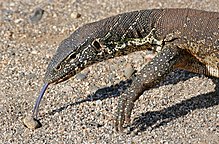
As in snakes and many mammals, all lizards have a specialised olfactory system, the vomeronasal organ, used to detect pheromones. Monitor lizards transfer scent from the tip of their tongue to the organ; the tongue is used only for this information-gathering purpose, and is not involved in manipulating food.[14][13]
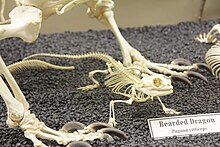
Some lizards, particularly iguanas, have retained a photosensory organ on the top of their heads called the parietal eye, a basal ("primitive") feature also present in the tuatara. This "eye" has only a rudimentary retina and lens and cannot form images, but is sensitive to changes in light and dark and can detect movement. This helps them detect predators stalking it from above.[15]
Venom
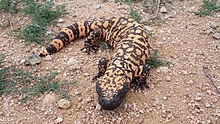
Until 2006 it was thought that the
Genes associated with venom toxins have been found in the salivary glands of a wide range of lizards, including species traditionally thought of as non-venomous, such as iguanas and bearded dragons. This suggests that these genes evolved in the common ancestor of lizards and snakes, some 200 million years ago (forming a single clade, the Toxicofera).[16] However, most of these putative venom genes were "housekeeping genes" found in all cells and tissues, including skin and cloacal scent glands. The genes in question may thus be evolutionary precursors of venom genes.[18]
Respiration
Recent studies (2013 and 2014) on the lung anatomy of the
Reproduction and life cycle
As with all amniotes, lizards rely on internal fertilisation and copulation involves the male inserting one of his hemipenes into the female's cloaca.[21] Female lizards also have hemiclitorises, a doubled clitoris. The majority of species are

In most lizards, the eggs have leathery shells to allow for the exchange of water, although more arid-living species have calcified shells to retain water. Inside the eggs, the embryos use nutrients from the yolk. Parental care is uncommon and the female usually abandons the eggs after laying them. Brooding and protection of eggs do occur in some species. The female prairie skink uses respiratory water loss to maintain the humidity of the eggs which facilitates embryonic development. In lace monitors, the young hatch close to 300 days, and the female returns to help them escape the termite mound where the eggs were laid.[22]
Around 20 percent of lizard species reproduce via
Sex determination in lizards can be
Aging
A significant component of aging in the painted dragon lizard Ctenophorus pictus is fading breeding colors.[27] By manipulating superoxide levels (using a superoxide dismutase mimetic) it was shown that this fading coloration is likely due to gradual loss with lizard age of an innate capacity for antioxidation due to increasing DNA damage.[27]
Behaviour
Diurnality and thermoregulation
The majority of lizard species are active during the day,[28] though some are active at night, notably geckos. As ectotherms, lizards have a limited ability to regulate their body temperature, and must seek out and bask in sunlight to gain enough heat to become fully active.[29] Thermoregulation behavior can be beneficial in the short term for lizards as it allows the ability to buffer environmental variation and endure climate warming.[30]
In high altitudes, the Podarcis hispaniscus responds to higher temperature with a darker dorsal coloration to prevent UV-radiation and background matching. Their thermoregulatory mechanisms also allow the lizard to maintain their ideal body temperature for optimal mobility.[31]
Territoriality
Most social interactions among lizards are between breeding individuals.[28] Territoriality is common and is correlated with species that use sit-and-wait hunting strategies. Males establish and maintain territories that contain resources that attract females and which they defend from other males. Important resources include basking, feeding, and nesting sites as well as refuges from predators. The habitat of a species affects the structure of territories, for example, rock lizards have territories atop rocky outcrops.[32] Some species may aggregate in groups, enhancing vigilance and lessening the risk of predation for individuals, particularly for juveniles.[33] Agonistic behaviour typically occurs between sexually mature males over territory or mates and may involve displays, posturing, chasing, grappling and biting.[32]
Communication

Lizards signal both to attract mates and to intimidate rivals. Visual displays include body postures and inflation, push-ups, bright colours, mouth gapings and tail waggings. Male
Several gecko species are brightly coloured; some species tilt their bodies to display their coloration. In certain species, brightly coloured males turn dull when not in the presence of rivals or females. While it is usually males that display, in some species females also use such communication. In the bronze anole, head-bobs are a common form of communication among females, the speed and frequency varying with age and territorial status. Chemical cues or pheromones are also important in communication. Males typically direct signals at rivals, while females direct them at potential mates. Lizards may be able to recognise individuals of the same species by their scent.[34]
Acoustic communication is less common in lizards. Hissing, a typical reptilian sound, is mostly produced by larger species as part of a threat display, accompanying gaping jaws. Some groups, particularly geckos, snake-lizards, and some iguanids, can produce more complex sounds and vocal apparatuses have independently evolved in different groups. These sounds are used for courtship, territorial defense and in distress, and include clicks, squeaks, barks and growls. The mating call of the male tokay gecko is heard as "tokay-tokay!".[35][34][38] Tactile communication involves individuals rubbing against each other, either in courtship or in aggression.[34] Some chameleon species communicate with one another by vibrating the substrate that they are standing on, such as a tree branch or leaf.[39]
Ecology


Distribution and habitat
Lizards are found worldwide, excluding the far north and Antarctica, and some islands. They can be found in elevations from sea level to 5,000 m (16,000 ft). They prefer warmer, tropical climates but are adaptable and can live in all but the most extreme environments. Lizards also exploit a number of habitats; most primarily live on the ground, but others may live in rocks, on trees, underground and even in water. The marine iguana is adapted for life in the sea.[6]
Diet
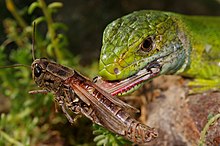
The majority of lizard species are
Termites are an important part of the diets of some species of Autarchoglossa, since, as


Larger species, such as monitor lizards, can feed on larger prey including fish, frogs, birds, mammals and other reptiles. Prey may be swallowed whole and torn into smaller pieces. Both bird and reptile eggs may also be consumed as well. Gila monsters and beaded lizards climb trees to reach both the eggs and young of birds. Despite being venomous, these species rely on their strong jaws to kill prey. Mammalian prey typically consists of rodents and leporids; the Komodo dragon can kill prey as large as water buffalo. Dragons are prolific scavengers, and a single decaying carcass can attract several from 2 km (1.2 mi) away. A 50 kg (110 lb) dragon is capable of consuming a 31 kg (68 lb) carcass in 17 minutes.[40]
Around 2 percent of lizard species, including many iguanids, are herbivores. Adults of these species eat plant parts like flowers, leaves, stems and fruit, while juveniles eat more insects. Plant parts can be hard to digest, and, as they get closer to adulthood, juvenile iguanas eat faeces from adults to acquire the
Antipredator adaptations
Lizards have a variety of
Camouflage
Lizards exploit a variety of different
The flat-tail horned lizard's body is coloured like its desert background, and is flattened and fringed with white scales to minimise its shadow.[46]
Autotomy
Many lizards, including geckos and skinks, are capable of shedding their tails (autotomy). The detached tail, sometimes brilliantly coloured, continues to writhe after detaching, distracting the predator's attention from the fleeing prey. Lizards partially regenerate their tails over a period of weeks. Some 326 genes are involved in regenerating lizard tails.[47] The fish-scale gecko Geckolepis megalepis sheds patches of skin and scales if grabbed.[48]
Escape, playing dead, reflex bleeding
Many lizards attempt to escape from danger by running to a place of safety;
Evolution
Fossil history

The closest living relatives of lizards are
Phylogeny
External
The position of the lizards and other Squamata among the reptiles was studied using fossil evidence by Rainer Schoch and Hans-Dieter Sues in 2015. Lizards form about 60% of the extant non-avian reptiles.[58]
Internal
Both the snakes and the
| Squamata |
| ||||||||||||||||||||||||||||||||||||||||||||||||||||||||||||||||||||||||||||||||||||||||||||||||||||||||||||||||||
Taxonomy

In the 13th century, lizards were recognized in Europe as part of a broad category of reptiles that consisted of a miscellany of egg-laying creatures, including "snakes, various fantastic monsters, […], assorted amphibians, and worms", as recorded by
Suborder Lacertilia (Sauria) – (lizards)
- Family †Bavarisauridae
- Family †Eichstaettisauridae
- Infraorder Iguanomorpha
- Family †Arretosauridae
- Family †Euposauridae
- Family Corytophanidae (casquehead lizards)
- Family spinytail iguanas)
- Family Phrynosomatidae (earless, spiny, tree, side-blotched and horned lizards)
- Family anoles)
- Family Leiosauridae (see Polychrotinae)
- Family Tropiduridae (neotropical ground lizards)
- Family Liolaemidae (see Tropidurinae)
- Family Leiocephalidae(see Tropidurinae)
- Family Crotaphytidae (collared and leopard lizards)
- Family Opluridae (Madagascar iguanids)
- Family Hoplocercidae (wood lizards, clubtails)
- Family †Priscagamidae
- Family †Isodontosauridae
- Family frilled lizards)
- Family Chamaeleonidae (chameleons)
- Infraorder Gekkota
- Family Gekkonidae (geckos)
- Family Pygopodidae (legless geckos)
- Family Dibamidae (blind lizards)
- Infraorder Scincomorpha
- Family †Paramacellodidae
- Family †Slavoiidae
- Family Scincidae(skinks)
- Family Cordylidae (spinytail lizards)
- Family Gerrhosauridae (plated lizards)
- Family Xantusiidae(night lizards)
- Family Lacertidae (wall lizards or true lizards)
- Family †Mongolochamopidae
- Family †Adamisauridae
- Family Teiidae (tegus and whiptails)
- Family Gymnophthalmidae (spectacled lizards)
- Infraorder Diploglossa
- Family Anguidae (slowworms, glass lizards)
- Family Anniellidae(American legless lizards)
- Family Xenosauridae (knob-scaled lizards)
- Infraorder Platynota (Varanoidea)
- Family Varanidae (monitor lizards)
- Family Lanthanotidae(earless monitor lizards)
- Family Helodermatidae (Gila monsters and beaded lizards)
- Family †Mosasauridae (marine lizards)

Convergence
Lizards have frequently
Relationship with humans
Interactions and uses by humans
Most lizard species are harmless to humans. Only the largest lizard species, the Komodo dragon, which reaches 3.3 m (11 ft) in length and weighs up to 166 kg (366 lb), has been known to stalk, attack, and, on occasion, kill humans. An eight-year-old Indonesian boy died from blood loss after an attack in 2007.[69]

Numerous species of lizard are kept as
In culture
Lizards appear in myths and folktales around the world. In
Lizards in many cultures share the symbolism of snakes, especially as an emblem of resurrection. This may have derived from their regular molting. The motif of lizards on Christian candle holders probably alludes to the same symbolism. According to Jack Tresidder, in Egypt and the Classical world, they were beneficial emblems, linked with wisdom. In African, Aboriginal and Melanesian folklore they are linked to cultural heroes or ancestral figures.[77]
Notes
- ^ Chameleon forefeet have groups composed of 3 inner and 2 outer digits; the hindfeet have groups of 2 inner and 3 outer digits.[6]
- ^ The BBC's 2016 Planet Earth II showed a sequence of newly-hatched marine iguanas running to the sea past a waiting crowd of racer snakes. It was edited for dramatic effect but the sections were all genuine.[50]
References
- ^ "The Reptile Database". Reptile-database.reptarium.cz. Retrieved on 2022-06-13
- ^ Muir, Hazel (3 December 2001). "Minute gecko matches smallest reptile record". New Scientist.
- ^ "The world's top 10 reptiles – in pictures". The Guardian. 5 May 2016.
- ISBN 978-0520266711.
- ^ Jones; et al. (2011). "Hard tissue anatomy of the cranial joints in Sphenodon (Rhynchocephalia): sutures, kinesis, and skull mechanics". Palaeontologia Electronica. 14(2, 17A): 1–92.
- ^ ISBN 978-1-55297-613-5.
- ISBN 978-1111425692.
- ^ Pough; et al. (2002) [1992]. Herpetology (Third ed.). Pearson Prentice Hall.
- ^ PMID 24970387.
- PMID 10101105– via jeb.biologists.org.
- Greenwood Press.
- ^ Pianka and Vitt, 23–24
- ^ ISBN 978-0-643-10642-0.
- PMID 20578170.
- ^ Brames, Henry (2007), "Aspects of Light and Reptile Immunity" (PDF), Iguana: Conservation, Natural History, and Husbandry of Reptiles, 14 (1): 19–23[permanent dead link]
- ^ S2CID 4386245.
- ^ a b Casey, Constance (26 April 2013). "Don't Call It a Monster". Slate.
- PMID 25449103.
- S2CID 4456381.
- PMID 25404314.
- ^ Pianka and Vitt, pp. 108.
- ^ a b Pianka and Vitt, pp. 115–116.
- ^ Pianka and Vitt, pp. 110–111.
- ^ Pianka and Vitt, pp. 117–118.
- ^ a b Pianka and Vitt, pp. 119.
- ^ Morales, Alex (20 December 2006). "Komodo Dragons, World's Largest Lizards, Have Virgin Births". Bloomberg Television. Retrieved 28 March 2008.
- ^ a b Olsson M, Tobler M, Healey M, Perrin C, Wilson M. A significant component of ageing (DNA damage) is reflected in fading breeding colors: an experimental test using innate antioxidant mimetics in painted dragon lizards. Evolution. 2012 Aug;66(8):2475-83. doi: 10.1111/j.1558-5646.2012.01617.x. Epub 2012 Apr 9. PMID 22834746
- ^ a b c Pianka and Vitt, pp. 86.
- ^ Pianka and Vitt, pp. 32–37.
- JSTOR 48577009.
- PMID 30875384.
- ^ a b Pianka and Vitt, pp. 94–106.
- .
- ^ a b c d Pianka and Vitt, pp. 87–94.
- ^ a b Langley, L. (24 October 2015). "Are Lizards as Silent as They Seem?". news.nationalgeographic.com. Archived from the original on October 25, 2015. Retrieved 9 July 2017.
- PMID 24335271.
- S2CID 18606633.
- ^ Frankenberg, E.; Werner, Y. L. (1992). "Vocal communication in the Reptilia–facts and questions". 41. Acta Zoologica: 45–62.
{{cite journal}}: Cite journal requires|journal=(help) - JSTOR 1447408. Archived from the original(PDF) on 2021-02-16. Retrieved 2017-07-11.
- ^ a b c d e f Pianka and Vitt, pp. 41–51.
- ^ Pianka and Vitt, pp. 53–55.
- ^ Pianka and Vitt, pp. 162.
- PMID 26804463.
- ^ Yong, Ed (16 July 2014). "Lizard 'Sees' With Its Skin For Automatic Camouflage". National Geographic. Archived from the original on July 19, 2014.
- PMID 18492645.
- ISBN 978-0-520-22825-2.
- ^ Scientists discover how lizards regrow tails, The Independent, August 20, 2014
- PMID 28194313.
- S2CID 84653226.
- ^ "From Planet Earth II, a baby iguana is chased by snakes". BBC. 15 November 2016.
- ^ Hewitt, Sarah (5 November 2015). "If it has to, a horned lizard can shoot blood from its eyes". BBC.
- S2CID 253160713.
- ISBN 978-1-108-93889-1, retrieved 2024-01-10
- PMID 33959350.
- ^ Dash, Sean (2008). Prehistoric Monsters Revealed. United States: Workaholic Productions / History Channel. Archived from the original on 2016-01-27. Retrieved December 18, 2015.
- PMID 30110414.
- ISSN 0024-4082.
- S2CID 205243837.
- PMID 25803280.
- PMID 22993238.
- PMID 26475614.
- ISBN 9780226260709.
- ^ James Macartney: Table III in: George Cuvier (1802) "Lectures on Comparative Anatomy" (translated by William Ross under the inspection of James Macartney). Vol I. London, Oriental Press, Wilson and Co.
- ^ Alexandre Brongniart (1800) "Essai d'une classification naturelle des reptiles. 1ère partie: Etablissement des ordres." Bulletin de la Science. Société Philomathique de Paris 2 (35): 81–82
- S2CID 83502693.
- .
- ^ S2CID 518045.
- .
- ^ "Komodo dragon kills boy in Indonesia". NBC News. 2007-06-04. Retrieved 2011-11-07.
- ^ a b Virata, John B. "5 Great Beginner Pet Lizards". Reptiles Magazine. Archived from the original on 17 May 2017. Retrieved 28 May 2017.
- ^ McLeod, Lianne. "An Introduction to Green Anoles as Pets". The Spruce. Retrieved 28 May 2017.
- ^ "Referencias culturales - todo iguanas verdes". Archived from the original on 2016-10-26. Retrieved 2018-11-25.
- ISBN 0-7876-5783-2(for vol.7). p. 48
- ^ "Alzheimer's research seeks out lizards". BBC. 5 April 2002.
- ISBN 978-0-7614-1580-0.
- ISBN 978-0-8130-1295-7.
- ISBN 978-1-85986-059-5.
General sources
- Pianka, E. R.; Vitt, L. J. (2003). Lizards: Windows to the Evolution of Diversity. University of California Press. ISBN 978-0-520-23401-7.
Further reading
- ISBN 978-0-394-50824-5.
- Capula, Massimo; Behler, John L. (1989). Simon & Schuster's Guide to Reptiles and Amphibians of the World. New York: ISBN 978-0-671-69098-4.
- ISBN 978-0-8317-2786-4.
- ISBN 978-0-395-58389-0.
- Ditmars, Raymond L (1933). Reptiles of the World: The Crocodilians, Lizards, Snakes, Turtles and Tortoises of the Eastern and Western Hemispheres. New York: Macmillan. p. 321.
- ISBN 978-0-87666-567-1.
- ISBN 978-0-8173-0135-4.
- Greenberg, Daniel A. (2004). Lizards. Marshall Cavendish. ISBN 9780761415800.
- Rosenfeld, Arthur (1987). Exotic Pets. New York: ISBN 978-0671636906.
External links
 Data related to Sauria at Wikispecies
Data related to Sauria at Wikispecies- Ernest Ingersoll (1920). . Encyclopedia Americana.






